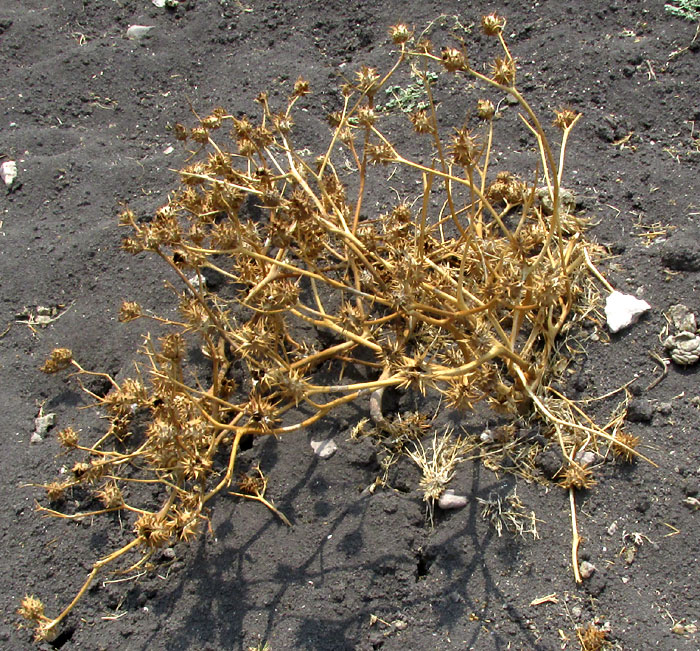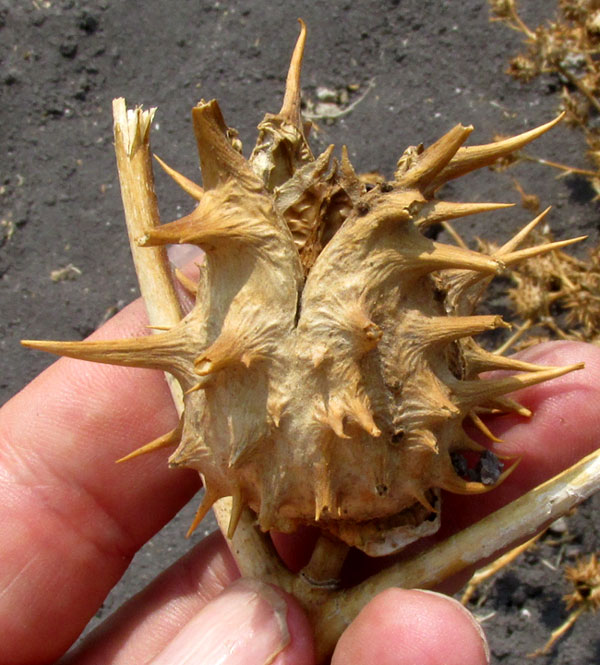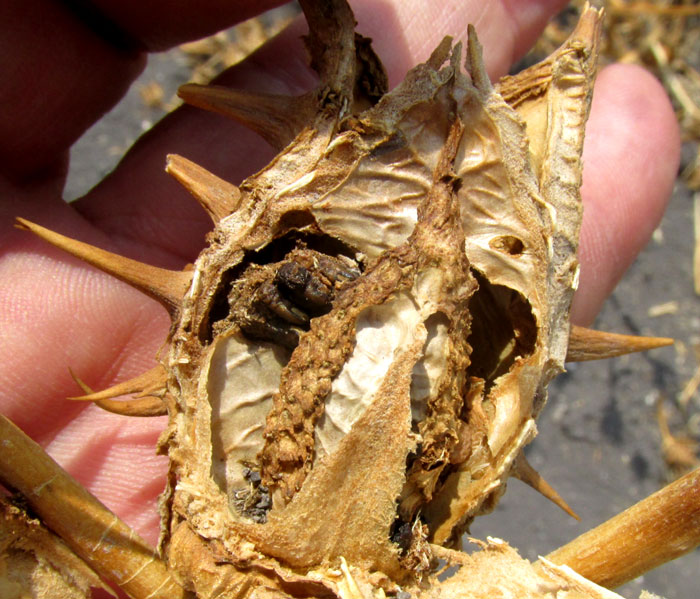Excerpts from Jim Conrad's
Naturalist Newsletter
entry dated April 6, 2023, with notes from near El Cerrito, 5kms south of Tequisquiapan; bedrock volcanic andesite, an intermediate rock between basalt and rhyolite; elevation about 2,000m (6600 ft), Querétaro state, MÉXICO
(~N20.47°, ~W99.89°)
OAKLEAF DATURA SKELETON

On the southeastern slope of El Cerrito, the town's reservoir was completely dry, during a dry season succeeding a rainy season that didn't develop as in the past. Now most of the reservoir's area that's normally underwater is unvegetated. However, on the reservoir's south-facing bank a population of several knee-high, dead and bleached plant remains were conspicuous and interesting looking, one of which is shown above.

Seeing the plants' split-open, seed-dropping, impressively spiny, capsular fruits, it was clear that these were daturas, genus Datura, of the Nightshade/Potato/Tomato Family, the Solanaceae. The capsule split only at the top, and one wonders how the seeds get out. Maybe the fact that these dead, dried-out plant skeletons all had been knocked over and trampled by wandering livestock, leaving seeds strewn across the ground, provides one answer. The above capsule was mostly empty, as seen when one side of the capsule was broken away:

Above, the three oblong, black items at the upper, left side of the fruit's pulpy core are remaining seeds. Below the seeds you see the papery remains of a wall which previously separated the fruit's seeds into four compartments, possibly the walls preventing the seeds from all dumping from the capsule at one time.
The GBIF Datura page currently recognizes 29 Datura taxa, though some specialists accept only 9 species. While all daturas are native to the US and Mexico south to Colombia, and the Caribbean, datura species occur nearly worldwide as weeds and grown as ornamental or medicinal plants. In our upland region of central Mexico known as the Bajío -- Mexico being considered the genus's center of origin -- five species are documented.
In our region, if you have a Datura with its capsules directed upward -- not on a downward-turning pedicel -- and the capsule's spines are of conspicuously variable sizes and are unequally spaced, with the terminal spines up to 1.5cm long (0.6inch), you have DATURA QUERCIFOLIA. In English the species is known by several names but maybe the easiest to remember is Oakleaf Datura. Also it bears several names by which it's considered a thorn-apple.
The big thing about any Datura species is the genus's fame for all parts of its plants being toxic and/or hallucinogenic. In Mexico Oakleaf Datura has a long history as an herbal medicine. The Mexican government's CONABIO page for the species reports its traditional use against asthma and to relax muscles, but warns that it's easy to poison oneself if not careful. George Swank in his 1932 book The Ethnobotany of the Acoma and Laguna Indians reports that Datura quercifolia roots are eaten to see into the future. The Flora del Bajío says that one of its uses is for fortune telling, "adivinación." Some places prohibit the sale or cultivation of all Datura plants.
Datura quercifolia contains a cocktail of alkaloids. As is written in the 2014 study by Shi Qui and others entitled "Natural alkaloids: basic aspects, biological roles, and future perspectives," it's stated that "Several alkaloids isolated from natural herbs exhibit antiproliferation, antibacterial, antiviral, insecticidal, and antimetastatic effects on various types of cancers both in vitro and in vivo."
The 1994 study by J.M. Dupraz and other others entitled "Tropane alkaloids in transformed roots of Datura quercifolia found that atropine, tropine, tropinone, pseudotropine, and scopolamine were the most abundant alkaloids in our plant. The effects and uses of these compounds can be looked up on the Internet. For example, atropine is used to reduce saliva and fluid in the respiratory tract during surgery. It's also used to treat insecticide and mushroom poisoning, and in emergencies can be used to treat slow heartbeat.
In 2018, Julia Dupin and Stacey Smith published a fascinating history of the evolution of the Datura tribe, the Datureae, based on genetic analysis. It's entitled, "Phylogenetics of Datureae (Solanaceae), including description of the new genus Trompettia and re-circumscription of the tribe." It suggests that the Datura Tribe arose in dry parts of South America about 35 million years ago, as the Andes were rising. Five million years later the genus Brugmansia -- a species of which is the famous garden plant Angel's Trumpet -- with its drooping flowers and fruits, and fleshy capsules, separated from the genus Datura, with its hard, dry capsules and some species with upward-directed flowers and fruits, as is the case with our Datura quercifolia.